
Ayida-Weddo, also known as Ayida, Ayida-Wedo, Aido Quedo, Aido Wedo, Aida Wedo, and Aido Hwedo, is a powerful loa spirit in Vodou, revered in regions across Africa and the Caribbean, namely in Benin and Haiti. Known as the "Rainbow Serpent", Ayida-Weddo is the loa of fertility, rainbows, wind, water, fire, wealth, thunder, and snakes. Alongside Damballa, Ayida-Weddo is regarded among the most ancient and significant loa. Considered in many sources as the female half of Damballa's twin spirit, the names Da Ayida Hwedo, Dan Ayida Hwedo, and Dan Aida Wedo have also been used to refer to her. Thought to have existed before the Earth, Ayida-Weddo assisted the creator goddess Mawu-Lisa in the formation of the world, and is responsible for holding together the Earth and heavens. Ayida-Weddo bestows love and well-being upon her followers, teaching fluidity and the connection between body and spirit.

Damballa, also spelled Damballah, Dambala, Dambalah, among other variations, is one of the most important of all loa, spirits in Haitian Voodoo and other African diaspora religious traditions such as Obeah. He is traditionally portrayed as a great white or black serpent, but may also be depicted as a rainbow. Damballa originated in the city of Wedo in modern-day Benin.

White Zombie is a 1932 pre-Code horror film independently produced by Edward Halperin and directed by Victor Halperin. The screenplay by Garnett Weston, based on The Magic Island by William Seabrook, is about a young woman's transformation into a zombie at the hands of an evil voodoo master. Bela Lugosi stars as the zombie master "Murder" Legendre, with Madge Bellamy appearing as his victim. Other cast members include Joseph Cawthorn, Robert W. Frazer, John Harron, Brandon Hurst, and George Burr MacAnnan.
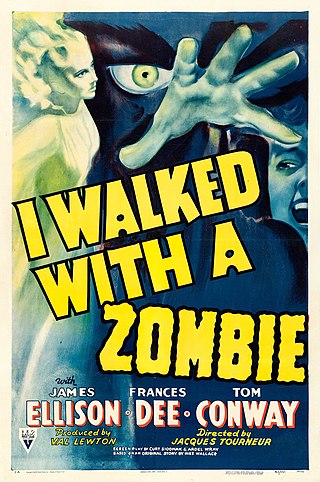
I Walked with a Zombie is a 1943 American horror film directed by Jacques Tourneur and produced by Val Lewton for RKO Pictures. It stars James Ellison, Frances Dee, and Tom Conway, and follows a Canadian nurse who travels to care for the ailing wife of a sugar plantation owner in the Caribbean, where she witnesses Vodou rituals and possibly encounters the walking dead. The screenplay, written by Curt Siodmak and Ardel Wray, is based on an article of the same title by Inez Wallace, and also partly reinterprets the narrative of the 1847 novel Jane Eyre by Charlotte Brontë.

The term Voodoo doll commonly refers to an effigy that is typically used for the insertion of pins. Such practices are found in various forms in the magical traditions of many cultures around the world.
A bokor (male) or caplata (female) is a Vodou priest or priestess for hire in Haiti who is said to serve the loa, "'with both hands', practicing for both good and evil." Their practice includes the creation of zombies and of ouangas.
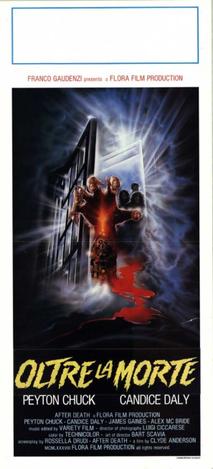
After Death is an Italian zombie film directed by Claudio Fragasso. The film is set on a remote island where a voodoo curse raises the dead from their graves to feast on the flesh of the living. When a boat of explorers—including a young girl who experienced the zombie uprising years earlier—makes an emergency docking on the island, the crew find that their only hope for survival is a protective idol given to the young girl by her mother years ago.
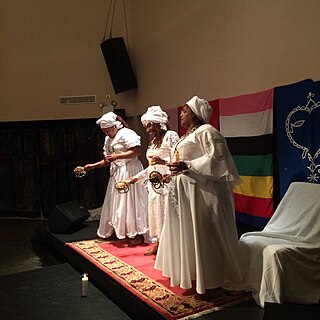
A manbo is a priestess in the Haitian Vodou religion. Haitian Vodou's conceptions of priesthood stem from the religious traditions of enslaved people from Dahomey, in what is today Benin. For instance, the term manbo derives from the Fon word nanbo. Like their West African counterparts, Haitian manbos are female leaders in Vodou temples who perform healing work and guide others during complex rituals. This form of female leadership is prevalent in urban centers such as Port-au-Prince. Typically, there is no hierarchy among manbos and oungans. These priestesses and priests serve as the heads of autonomous religious groups and exert their authority over the devotees or spiritual servants in their hounfo (temples).

William Buehler Seabrook was an American occultist, explorer, traveler, journalist and writer, born in Westminster, Maryland. He began his career as a reporter and city editor of the Augusta Chronicle in Georgia, worked at the New York Times, and later became a partner in an advertising agency in Atlanta. He is well-known for his writing on, and engaging in, cannibalism.

Sallie Ann Glassman is an American practitioner of Vodou, a writer, and an artist. She was born in Kennebunkport, Maine and is a self-described "Ukrainian Jew from Maine", and a former member of Ordo Templi Orientis.
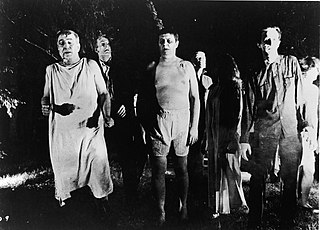
A zombie is a mythological undead corporeal revenant created through the reanimation of a corpse. In modern popular culture, zombies are most commonly found in horror and fantasy genre works. The term comes from Haitian folklore, in which a zombie is a dead body reanimated through various methods, most commonly magical practices in religions like Vodou. Modern media depictions of the reanimation of the dead often do not involve magic but rather science fictional methods such as carriers, fungi, radiation, mental diseases, vectors, pathogens, parasites, scientific accidents, etc.
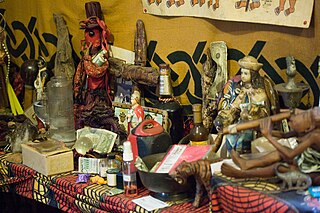
Louisiana Voodoo, also known as New Orleans Voodoo, is an African diasporic religion that originated in Louisiana. It arose through a process of syncretism between the traditional religions of West Africa, the Roman Catholic form of Christianity, and Haitian Vodou. No central authority is in control of Louisiana Voodoo, which is organized through autonomous groups.
Witchcraft: Its Power in the World Today is a book by William Buehler Seabrook which was published in 1940. It details the author's views on psychology, parapsychology and the occult, and contains information about the author's meetings with a number of famous people.
Vodou drumming and associated ceremonies are folk ritual faith system of henotheistic religion of Haitian Vodou originated and inextricable part of Haitian culture.

The Serpent and the Rainbow: A Harvard Scientist's Astonishing Journey into the Secret Societies of Haitian Voodoo, Zombies, and Magic is a 1985 book by anthropologist and researcher Wade Davis. He investigated Haitian Vodou and the process of making zombies. He studied ethnobotanical poisons, discovering their use in a reported case of a contemporary zombie, Clairvius Narcisse.

Faustin Edmond Wirkus was an American marine stationed in Haiti during the United States occupation of Haiti (1915–1934). He was reputedly crowned Faustin II, King of La Gonâve, a Haitian island west of Hispaniola, by Queen Ti Memenne of La Gonâve on 18 July 1926, and co-ruled as monarch for 3 years until he was transferred by the United States Marine Corps to the United States mainland in 1929.

Voodoo: Truth and Fantasy is a 1993 illustrated monograph on Haitian Vodou. Written by the Haitian sociologist of religion Laënnec Hurbon, and published in pocket format by Éditions Gallimard as the 190th volume in their 'Découvertes' collection.

Queen Ti Memenne of La Gonâve was the tribal ruler of La Gonâve, a Haitian island located west of Hispaniola in the Gulf of Gonâve, in the 1920s. While her reign was not officially recognized by the republican government of Haiti during American occupation, she maintained political, economic, spiritual, and social leadership of the island. Arrested by the Garde d'Haiti for being a practitioner of Vodou, she was shown compassion by Faustin E. Wirkus, an American military officer who assisted in her release. She later proclaimed Wirkus to be the reincarnation of former Haitian Emperor Faustin Soulouque and crowned him as a co-ruler over La Gonâve.
Voodoo in popular culture encompasses various representations of practices associated with different forms of voodoo, including Haitian Vodou and Louisiana Voodoo, and other elements attributed to African diaspora religions, with such representations often deviating substantially from any actual voodoo practices or beliefs. Tropes regarding voodoo appear most often in supernatural fantasy or horror films, with common themes including the activity of witch doctors, the summoning or control of dark spirits, use of voodoo dolls to inflict pain on people remotely, and the creation of zombies.

Murder Legendre is a fictional character and the antagonist of the 1932 black-and-white horror film White Zombie where he was portrayed by actor Bela Lugosi.















